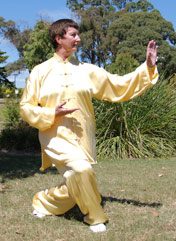Tai Chi Training Smart – strategic approaches to training higher physical skills
Tai Chi training with Golden Lion Sifu Di Logan: she explains below how you can achieve higher physical skills by training smart.

Take baby steps:
It is very hard, if not impossible, to get from “Doing something more, but doing it wrong” to “Doing something more and getting it right”, because it is hard to make corrections from an extreme position – a bit like going a long way on the wrong road to your destination.
During tai chi training, it is easier and more effective to move in stages from “Doing it less, but doing it right” to “Doing it more and doing it right”. It is physically easier, but emotionally more difficult, because you have to postpone early apparent “achievements” to reach later, more valid ones. You have to be patient and persistent, and sometimes you have to disregard praise and admiration from people who are impressed by the more obvious “flashy” achievement, in order not to be seduced away from your real goal: to “Do it more AND do it right”.
Focus and simplify:
Intensively training strength and flexibility at the same time as trying to train detailed, correct hand shapes, hand/arm pathways, footwork, leg techniques, and body techniques often leads to students over emphasising extreme end goals and neglecting the processes of body alignment and coordination. Thus losing the two most valuable of Tai Chi’s physical tools, and usually losing accuracy of movement as well.
The “KISS” principle works well (Keep It Simple and Stupid) for tai chi training:
When working on learning or refining details of movements, work within lesser demands of strength and flexibility. (It’s hard to focus on an exact pathway of arm or leg when when you are wondering if you are about to fall on the floor.)
If you want to improve strength in a big way, keep it simple. Use exercises which focus on the specific strengths while maintaining correct body alignment. Take the time to learn which muscles produce specific strengths, and relate your exercises to this knowledge.
When training for strength, put aside the demands of whole movements for a time and concentrate on stances alone, or even work out which specific muscles require additional strength in order to produce a movement to the standard you desire, and do exercises which focus on those muscles.
Don’t forget the small stuff:
Whichever groups of muscles you focus on, however, you will not achieve effective strength unless strength training includes the muscles required for maintaining body alignment and stability.
If you want to improve flexibility, use stretches which focus on the specific flexibilities, while maintaining correct body alignment. Take the time to learn which joints are used for specific flexibility and about the structure of those joints and about the soft tissues around them.
Focus on process rather than product:
When doing stretching exercises for flexibility it is more important to know which muscles you are intending to stretch, than to focus on end goals. While the latter are helpful, focusing mainly on them can lead to us confusing distortion of the body with true flexibility. For example, reaching your foot to the higher bars on the stretching rack while raising your hip and curving your spine sideways, and/or excessively tilting your pelvis to reach higher is not a true indication of flexibility as the muscles that you thought you were stretching are not actually lengthening.
In addition, if you apply this method to kick higher in drills or routines, the repetition of a warped body alignment under dynamic circumstances will eventually lead to physical problems, or even injury. Similarly, curving your spine to desperately reach your toes in a hamstring stretch is not actually stretching your hamstrings effectively, it is just bending your back. These are examples of “doing it more but doing it wrong”.
Pain is a message, listen to it:
If you find that you are experiencing back, hip or knee problems after or during a period of heavy tai chi training, it is worth checking that you have not neglected the maintenance of correct body alignment during stretching, strength, or routines training.
Correct body alignment + Coordination = Power
In addition, correct body alignment is a common factor in functionally effective strength and flexibility. This, together with coordination, is what produces power from strength. It is what produc es adaptability and resilience from flexibility.
es adaptability and resilience from flexibility.
Body alignment is very difficult to assess on your own by “how it feels”. Your proprioceptors (position sensors within your muscles) may have become used to incorrect positions and give you misleading information. You need another person to give you feedback, or videos, photos and mirrors can be helpful. Sometimes physical structures with straight lines such as walls or posts can be useful guides. I have often found evidence such as photos and videos to be almost essential to provide information that the person can verify for themselves, as their bodies just don’t “feel” the feedback to be true.
In the course of all this specific strength and flexibility work with our bodies in correct alignment, do keep in mind that strength does not necessarily equal power, nor does flexibility automatically lead to adaptability and resilience. For functional effectiveness, we need to deliberately train timing and coordination together with strength and flexibility. But that’s a strategy for another day and more thought.
More information about our programmes can be found here.
